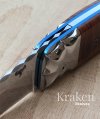ilknives
Knifemaker / Craftsman / Service Provider
- Joined
- Oct 19, 2017
- Messages
- 374
Hi! I have searched this topic and found a thread from 2012 so thought not to Lazarus it.
I wondered two things:
Whether others also had the titanium crack or chip on peening 6-4 titanium pins in 6-4 titanium bolsters, this happened more than I cared for, and what solutions they used.
Secondly, I have started to use a 30T hydraulic press I built to press them and this seems to work much better. Perhaps because the force is delivered slow and gradually and there is some heat generation (compared to hammer blows) the risk of fracture is less. The other effect seems to be that the whole length of the pin swells, this was v handy as I used a strip of wood veneer each side to allow pressure to close the gap first before the dies contact the titanium pins. Problem was I then applied more pressure and the veneer deformed the bolster!! I was however able to grind down from the surface about a fifth of the thickness without the pins starting to show, to get it flat again.
Thanks
Ig
I wondered two things:
Whether others also had the titanium crack or chip on peening 6-4 titanium pins in 6-4 titanium bolsters, this happened more than I cared for, and what solutions they used.
Secondly, I have started to use a 30T hydraulic press I built to press them and this seems to work much better. Perhaps because the force is delivered slow and gradually and there is some heat generation (compared to hammer blows) the risk of fracture is less. The other effect seems to be that the whole length of the pin swells, this was v handy as I used a strip of wood veneer each side to allow pressure to close the gap first before the dies contact the titanium pins. Problem was I then applied more pressure and the veneer deformed the bolster!! I was however able to grind down from the surface about a fifth of the thickness without the pins starting to show, to get it flat again.
Thanks
Ig






